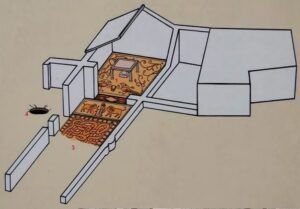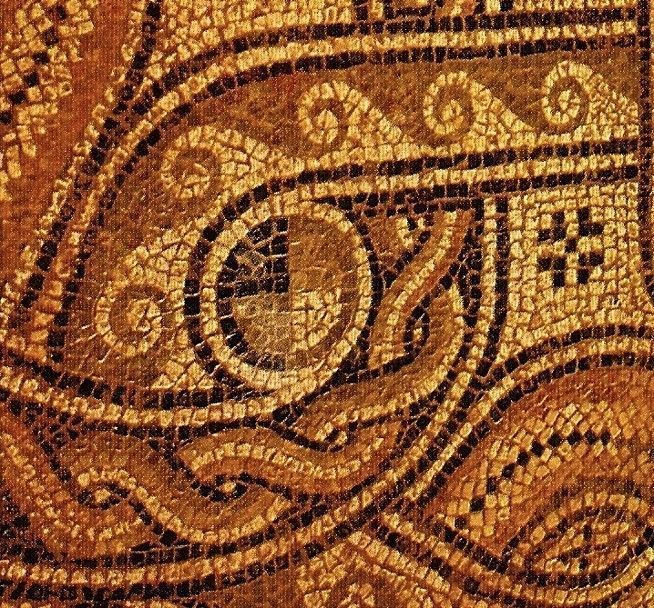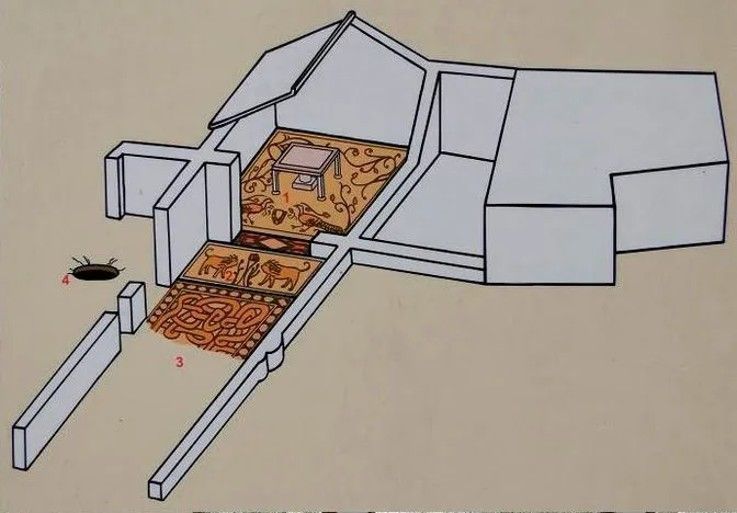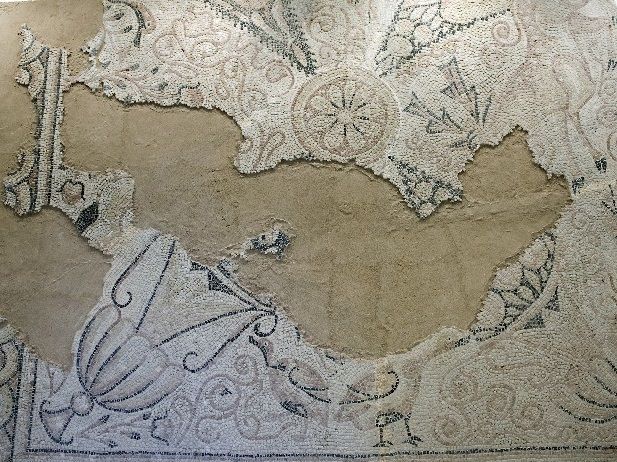BASÍLICA DE FORNÀS DE TORELLÓ

Historic environment
The Fornàs de Torelló deposit is located in the municipality of Mahón, one kilometer north of the Menorca airport. Only a small part of it has been excavated, but it should be noted that you can visit its basilica and see its magnificent mosaics. There is good knowledge of the existence of other buildings in the immediate vicinity of the church, as well as important prehistoric sites in its surroundings. There is also evidence of human occupation of the environment in the Islamic period (10th-13th centuries AD).
The foundational dating of the ecclesiastical complex is usually placed between the 5th and 6th centuries AD. C. and, the mosaics, in the 6th century. As in the other Menorcan basilicas, the original function of the building of worship is not at all clear.  It has been suggested, for example, that it could be part of a “village” and, above all, of a monastery. It is unknown until when it could be in use.
It has been suggested, for example, that it could be part of a “village” and, above all, of a monastery. It is unknown until when it could be in use.
It should be noted that the basilica of Fornàs de Torelló is very similar to that of Isla del Rey, both in terms of mosaics and its architectural ensembles. These similarities are convincing enough to suggest that the Fornás de Torelló complex was also a monastery of which only a part has been excavated. On the other hand, it has been proven that the smallest basilicas discovered in the Balearic Islands are precisely those of Isla del Rey and Fornàs de Torelló (the first could house a maximum of 200 individuals, while the second 120 at most). and that, therefore, they were intended to serve small communities, most probably monastic.
Immediately to the southeast of the church, several rooms were excavated whose chronology has not been determined and which present a radically different orientation (SE/NW) to that of the basilica (E/W). It should also be noted that the two sets do not present the same construction technique either, the dependencies being simpler, with smaller and less worked stones, bound with clay.
Description
In the basilica of Fornàs de Torelló you can see the most spectacular set of mosaics in Menorca. With regard to the building, it should be noted that most researchers consider it to have a single nave, but there are also those who propose that it had three naves. In the first proposal, the baptismal pool of the place would be in a building attached to the church, while in the second, said pool would be inside it.
With regard to the basilica building, S. Alcaide (2011), an author who has analyzed it in detail and more recently, describes it with a rectangular classroom and an undifferentiated head. The total external longitudinal dimension of the complex would be about 18.1-18.3 m, while the external width would be between 6 and 6.1 m. The nave and the area of the baptistery would have an approximate length of 13.8-14 m and the width of the latter from the outside would correspond to half that of the church, that is to say, about 3-3.1 m. In general, the walls of the building are  make up a double masonry wall of small and medium-sized stones, bound with lime, sand and gravel mortar. The internal filling is made up of small stones and calcareous mortar. The corners are reinforced with larger blocks and the openings with squared and rough stone blocks, which in turn act as braces. The interior facing of the church walls was covered with mortar, which is made up mostly of lime and sand, with inclusions of gravel and ceramic debris. The remains of this plaster are preserved in the southeast corner of the church nave and, above all, inside the chancel. At the time of the excavation, the remains of the plaster on the walls formed a layer of mortar of about 10 cm that extended over the surface of the mosaic of the church (Serra, 1959: 289). The thickness of the walls is 0.72 m on its north side and 0.75 m on the south. The church has a unique rectangular head, which is an extension of the side walls of the nave. The depth is 5.44 m from the outside and 4.2 m inside. The entrance to this space from the nave was through a wide opening, with a span of about 2.8 m, opened in the wall that borders it on the west. The access is flanked by pilasters, which must have supported a large arch.
make up a double masonry wall of small and medium-sized stones, bound with lime, sand and gravel mortar. The internal filling is made up of small stones and calcareous mortar. The corners are reinforced with larger blocks and the openings with squared and rough stone blocks, which in turn act as braces. The interior facing of the church walls was covered with mortar, which is made up mostly of lime and sand, with inclusions of gravel and ceramic debris. The remains of this plaster are preserved in the southeast corner of the church nave and, above all, inside the chancel. At the time of the excavation, the remains of the plaster on the walls formed a layer of mortar of about 10 cm that extended over the surface of the mosaic of the church (Serra, 1959: 289). The thickness of the walls is 0.72 m on its north side and 0.75 m on the south. The church has a unique rectangular head, which is an extension of the side walls of the nave. The depth is 5.44 m from the outside and 4.2 m inside. The entrance to this space from the nave was through a wide opening, with a span of about 2.8 m, opened in the wall that borders it on the west. The access is flanked by pilasters, which must have supported a large arch.
Inside the apse, a large part of the main altar of the monument could be recovered. Many of his pieces were made of marble. So were other items discovered at the site. It seems that this apse could have been flanked by two side chambers (to the north and south), although the only safe one is the one at noon.
The baptismal pool has a circular plan both inside and outside. The preserved part is made of stones bound with mortar and has a plaster of opus signinum.
Graves have been documented in various areas of the site, but only a few have been excavated. All those documented correspond to burials, among which adult and child individuals were documented.
Mateu Riera Rullan for URBS REGIA
Other interesting information
Access: Open all year long. Free visit.
Bibliography
SERRA, Mª. L., (1959): “Una nueva basílica paleocristiana en Menorca”, Actas del V Congreso Nacional de Arqueología, Zaragoza, 288-291.
PALOL, P. de., (1967): Arqueología cristiana de la España romana, siglos IV-VI, Madrid – Valladolid.
GUÀRDIA PONS, M., (1988): “Les basíliques cristianes de Menorca: Es Fornàs de Torellò i S’Illa del Rei, i els tallers de musivària Balears”, Les Illes Balears en temps cristians fins als àrabs, Maó, 65-72.
ALCAIDE, S., (2011): Arquitectura cristiana balear en la Antigüedad tardía (siglos V-X d.C.), Tesi doctoral de la Universitat Rovira i Virgili. Departament d’Història i Història de l’Art, Tesis Doctorals en Xarxa, http://www.tesisenred.net/handle/10803/32933.
Portals











